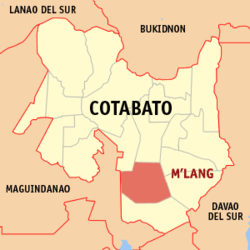M'lang, Cotabato
| M'lang | ||
|---|---|---|
| Municipality | ||
| ||
 Map of Cotabato with M'lang highlighted | ||
.svg.png) M'lang Location within the Philippines | ||
| Coordinates: 6°57′N 124°53′E / 6.95°N 124.88°ECoordinates: 6°57′N 124°53′E / 6.95°N 124.88°E | ||
| Country | Philippines | |
| Region | SOCCSKSARGEN (Region XII) | |
| Province | Cotabato | |
| District | 3rd District of Cotabato | |
| Incorporated | August 3, 1951 | |
| Barangays | 37 | |
| Government[1] | ||
| • Mayor | Russel Abonado | |
| Area [2] | ||
| • Total | 312.13 km2 (120.51 sq mi) | |
| Population (2015 census)[3] | ||
| • Total | 95,070 | |
| • Density | 300/km2 (790/sq mi) | |
| Demonym(s) | Mlangeños | |
| Time zone | PST (UTC+8) | |
| ZIP code | 9402 | |
| IDD : area code | +63 (0)64 | |
| Income class | 1st municipal income class | |
| PSGC | 124710000 | |
| Electorate | 49,957 voters (2016) | |
| Website |
www | |
M'lang (Hiligaynon: Banwa sang M'lang; Filipino: Bayan ng M'lang) is a first class Municipality in the Province of Cotabato, Philippines. According to the 2015 census, it has a population of 95,070 people.[3]
Barangays
M'lang is politically subdivided into 37 Barangays. [2]
- Bagontapay
- Bialong
- Buayan
- Calunasan
- Dalipe
- Dugong
- Dungo-an
- Gaunan
- Inas
- Katipunan
- La Fortuna
- La Suerte
- Langkong
- Lepaga
- Liboo
- Lika
- Luz Village
- Magallon
- Malayan
- New Antique
- New Barbaza
- New Kalibo
- New Consolacion
- New Esperanza
- New Janiuay
- New Lawa-an
- New Rizal
- Nueva Vida
- Pag-asa
- Poblacion A
- Poblacion B
- Pulang-lupa
- Sangat
- Tawantawan
- Tibao
- Ugpay
- Palma-Perez
History
The Name M'lang was derived from a Maguindanaoan word Tamlang which means "bamboo".
In 1930's Migrants From Visayas (Panay) and some parts of Luzon settled in M'lang. Jacinto Paclibar, who was in search for more fertile lands and vast settlement was the first Christian who settled in M'lang. He became the District Mayor of Kidapawan and Deputy Governor of the Empire Province of Cotabato under Datu Udtog Matalam.He had in mind a government assisted subdivision project so that landless settlers may have their share to utilize fertile lands for farming and settlement.
M'lang became regular Municipality on August 3, 1951, by virtue of Executive Order No. 462 of the President of the Philippines by the then President Elpidio Quirino, with territories taken from the adjacent towns of Kidapawan (its mother municipality) and Buluan of the now Maguindanao Province.
Demographics
| Population census of M'lang | ||
|---|---|---|
| Year | Pop. | ±% p.a. |
| 1960 | 42,085 | — |
| 1970 | 44,844 | +0.64% |
| 1975 | 51,596 | +2.85% |
| 1980 | 57,059 | +2.03% |
| 1990 | 68,971 | +1.91% |
| 1995 | 71,846 | +0.77% |
| 2000 | 78,170 | +1.82% |
| 2007 | 86,321 | +1.38% |
| 2010 | 87,749 | +0.60% |
| 2015 | 95,070 | +1.54% |
| Source: Philippine Statistics Authority[3][4][5][6] | ||
In the 2015 census, the population of M'lang was 95,070 people,[3] with a density of 300 inhabitants per square kilometre or 780 inhabitants per square mile.
Transportation
The North Cotabato Rural Airport, in barangay of Tawan-tawan, is intended to serve as the primary air transport hub for agricultural produce of Cotabato and those coming from central Mindanao. It has a 1.2 kilometer runway with a capability for commercial flights, but there are no scheduled flights.[7]
Education
- Notre Dame of M'lang
- Mlang Pilot Elementary School
- Mlang National High School
- Southern Baptist College
- Mariano Untal Memorial High School
- Bagontapay Central Elementary School
References
- ↑ "Official City/Municipal 2013 Election Results". Intramuros, Manila, Philippines: Commission on Elections (COMELEC). 12 May 2014. Retrieved 3 June 2014.
- 1 2 "Province: North Cotabato". PSGC Interactive. Quezon City, Philippines: Philippine Statistics Authority. Retrieved 12 November 2016.
- 1 2 3 4 Census of Population (2015). "Region XII (Soccsksargen)". Total Population by Province, City, Municipality and Barangay. PSA. Retrieved 20 June 2016.
- ↑ Census of Population and Housing (2010). "Region XII (Soccsksargen)". Total Population by Province, City, Municipality and Barangay. NSO. Retrieved 29 June 2016.
- ↑ Census of Population (1995, 2000 and 2007). "Region XII (Soccsksargen)". Total Population by Province, City and Municipality. NSO. Archived from the original on 24 June 2011.
- ↑ "Province of North Cotabato". Municipality Population Data. Local Water Utilities Administration Research Division. Retrieved 17 December 2016.
- ↑ Arguillas, Carolyn O. (February 20, 2016). "M’lang airport’s first use: to fly a plane seeding clouds". www.mindanews.com. Mindanews. Retrieved 9 January 2017.

